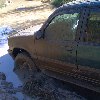Medic531
Well-Known Member
- Joined
- April 11, 2015
- Messages
- 129
- Reaction score
- 12
- City, State
- Moore, Oklahoma
- Year, Model & Trim Level
- 2019 Explorer 4x4 XLT
So a friend and I were changing my rotors on my 15 ex tonight and we got stuck on the front right wheel with the rotor screw. The screw ended up getting stripped and we tried everything we had and knew at the time to get the screw off. Finally we used a dremel to remove the head of the screw or tried to and now the screw and the rotor screw hole is so messed up its hard to tell where the screw is as the metal from the rotor and the scrw now blends in together. We are pretty sure either the entire head is off or very close to it but cannot get the rotor to come off. I searched on here for some ways to get the rotors off for when they are rusty and I may end up trying the bolts thru the caliper holes to push the rotor off. If I have to I can prob take it to a shop and have it removed.....the point of this thread is are the rotor screws even required for safe operation? My friend and I have never seen rotors with retaining screws before. So at the time of this post I have the front left rotor replaced and screwed in nicely while the old front right rotor is still on there.










